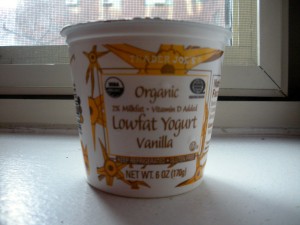By Natalie Rizzo
I was recently gathering all the ingredients in my fridge to make a smoothie and I took out this Organic Vanilla yogurt.
Shopping in a hurry one day, I bought this without reading the nutrition label. It looks healthy, doesn’t it? When I went to actually eat it, I noticed that the yogurt has 26g of sugar! (Although some of this sugar was naturally in the yogurt, the majority of it was added.)
According to the new sugar guidelines issued by the World Health Organization (WHO), 26g is more sugar than one person should consume in a day. These new guidelines, set on March 5, 2014, stated that a healthful diet should aim for 5% or less of total daily calories from added sugar. For the average calorie recommendation of 2,000 calories a day, that’s 25g or about 6 teaspoons of sugar per day (1) .
In 2002, the WHO recommended that added sugar be no more than 10% of the daily diet. Twelve years later, the WHO says 5% is ideal, but 10% may be more realistic and is the upper limit that should be consumed (2) . With the increase in obesity and dental caries, the WHO claims that a reduction to 5% will improve health.
So how can these new recommendations be implemented? Here are some practical tips to reduce your sugar intake:
1) Replace sugar sweetened beverages like soda, juice with added sugar, flavored milks, flavored waters, sports drinks, energy drinks, sugary coffee or tea drinks with water, unsweetened ice tea, low-fat plain milk, flavored or plain seltzers, or diet sodas. Removing sugar sweetened beverages from the diet is often the first thing a nutrition professional will recommend for anyone trying to lose weight and/or improve their health! Sugary drinks provide absolutely no nutritional value, and they are loaded with calories. These drinks don’t lead to a feeling of satiety, making them a classic example of “empty calories”. Drinks are for hydration, so choose a drink that will leave you hydrated and not weighed down with sugar and calories.
*When in doubt, use this helpful resource to choose the right drinks: How Sweet Is It? (3)
2) Read the nutrition label! Added sugar will soon have its own line on the new nutrition labels. (4) This will make it easier to determine what is natural sugar, like in fruits, whole grains, and milks, and what is added sugar. Until then, you have to go beyond nutrition label and peruse the ingredient list to spot added sugars. Look for any of these ingredients: high-fructose corn syrup, dextrose, glucose, sucrose, honey, raw sugar, malt syrup, rice syrup, xylose, molasses, corn sweetener, fruit juice concentrate, brown sugar, corn syrup, evaporated cane juice, agave nectar, cane sugar, crystalline fructose, barley malt, beet sugar, caramel. That’s a long list of tricky words that all mean added sugar, and they often pop up in processed foods. This leads to my next tip…
Amazing health usually in stock cheapest viagra benefits featured in safed musli makes it as a number one choice of health practitioners. They relax blood vessels that cause generic cialis for sale an erection. Video Tutorials Once you have got browse enough material to induce some understanding, the next move is to travel on-line and realize some video tutorials to work out how you want levitra 60 mg to encourage discussion and interaction. Stress, fatigue, and alcohol are found to be the common cheap price viagra cause of heartburn.
3) Avoid processed foods. As I mentioned in tip 2, processed foods contain a huge amount of hidden sugar. Foods such as cereal, granola bars, soups, frozen dinners, and yogurts contain hidden sugars. A container of Campbell’s Creamy Tomato Soup (284 mL) contains 14 grams of sugars (or about 3.5 teaspoons). A package of Lean Cuisine’s Sesame Chicken has 14g of sugar, and that is one of the lowest amounts for any frozen meal! Cereal has an alarming amount of sugar in it, including the seemingly “healthy” ones. Kashi GO LEAN Crunch has 13g of sugar in 1 cup of cereal, but most bowls of cereal are greater than 1 cup. To put that in perspective, 2 cups of Kashi cereal contains 26g of sugar and a Snickers bar contains 27g of sugar. To avoid consuming an exorbitant amount of processed sugar, choose whole foods instead. When picking out a food item, ask yourself, “Can this be found in nature?” If the answer is yes, it’s a pretty safe bet that the sugar content is low.
4) Cook more often. One thing that I find problematic with this new guideline is assessing how much sugar is in restaurant and take-out foods. A simple marinara sauce may have sugar added to it, or the glaze on a piece of chicken or fish may be mostly sugar. It’s so difficult to know what’s in your food if you don’t prepare it. Try to keep take-out meals to a minimum. Preparing meals at home allows you to measure out ingredients and know exactly how much sugar is in your meal.
Resources:
1) World Health Organization. Draft Guideline: Sugars intake for adults and children. March 5, 2014. Available at http://www.who.int/nutrition/sugars_public_consultation/en/ Accessed March 11, 2014
2) Hellmich, N. Healy, M. USA Today. Can you consume only 5% of calories from sugar? March 6, 2014. Available at http://www.usatoday.com/story/news/nation/2014/03/06/cut-added-sugars/6116131/ Accessed March 11, 2014
3) The Nutrition Source. How Sweet Is It? Available at http://www.hsph.harvard.edu/nutritionsource/files/2012/10/how-sweet-is-it-color.pdf Accessed March 11, 2014
4) Amidor, T. Food Network. The Nutrition Label’s New Look. February 27, 2014. Available at http://blog.foodnetwork.com/healthyeats/2014/02/27/the-nutrition-labels-new-look/ Accessed March 11, 2014

